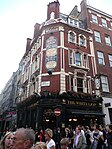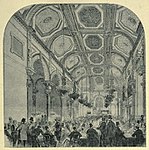Covent Garden tube station
1907 establishments in EnglandCovent GardenFormer Great Northern, Piccadilly and Brompton Railway stationsLeslie Green railway stationsLondon Underground Night Tube stations ... and 6 more
Piccadilly line stationsRail transport stations in London fare zone 1Railway stations in Great Britain opened in 1907Railway stations located underground in the United KingdomTube stations in the City of WestminsterUse British English from April 2013

Covent Garden is a London Underground station serving Covent Garden and the surrounding area in the West End of London. It is on the Piccadilly line between Leicester Square and Holborn stations and is in Travelcard Zone 1. The station is at the corner of Long Acre and James Street and the street-level concourse is a Grade II listed building.
Excerpt from the Wikipedia article Covent Garden tube station (License: CC BY-SA 3.0, Authors, Images).Covent Garden tube station
James Street, City of Westminster Covent Garden
Geographical coordinates (GPS) Address Nearby Places Show on map
Geographical coordinates (GPS)
| Latitude | Longitude |
|---|---|
| N 51.513 ° | E -0.1243 ° |
Address
Covent Garden Station
James Street
WC2E 8BU City of Westminster, Covent Garden
England, United Kingdom
Open on Google Maps







